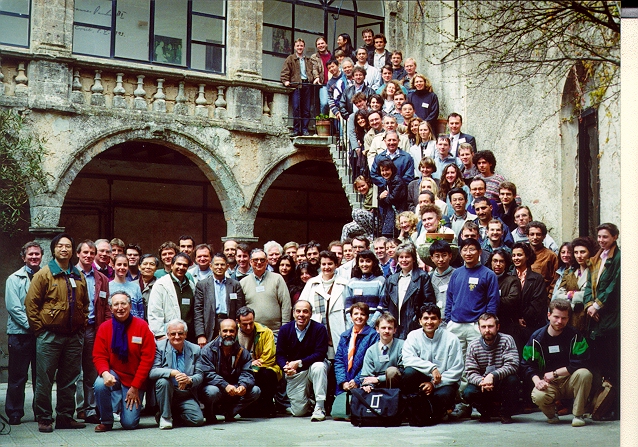X-Ray and Neutron Dynamical Diffraction - Theory and Applications,
Erice, 9-21
April 1996. A Report.
a NATO Advanced
Study Institute
sponsored
by the International Union of Crystallography
The 23rd
crystallographic course at the Ettore Majorana Centre, Erice, Sicily, Italy,
was run as a Nato Advanced Study Institute with A. Authier (Paris) and S.
Lagomarsino (Rome) as co-Directors, P. Spadon (Padova) and L. Riva di Sanseverino
(Bologna) as local organizers, R. Colella (Purdue) and B. Tanner (Durham)
being the other members of the organizing committee.
The main reason for
planning the course is the strong revival of the applications of dynamical
diffraction which are brought about by the Synchrotron Radiation (SR) and, in
particular by the possibilities offered by the third generation SR sources.
About one hundred
participants from twenty four different countries took part under Paola's and
Lodovico's watchful eyes. They listened to 48 main lectures (judged too many in
the questionnaire), discussed 42 posters during two poster sessions, worked out
several exercises during tutorials and tried computer programs brought by the
invited speakers. The leisure time (judged "too limited" by a
significant number of participants) included two half-day archaeological
excursions, dry and sunny weather (!!!!) throughout the full duration and
evening Marsala wine tasting......

The photo shows along the
first row Lodovico, ……,………, Stefano Lagomarsino, Bob Batterman,
Paola, ……
and along the second row Henk Schenk, six to be nominated, Andre Authier,
….., Manuela
Panzalorto,
….
The second part considered
the principles of the various techniques used in the modern applications of
dynamical diffraction which are very varied in nature. Several contributions
were devoted to x-ray and neutron diffraction topography which enables the
direct imagingof crystal defects. The various settings were described and the
new possibilities opened by the third generation SR sources were pointed out. The
theoretical interpretation of contrast was given for various types of defects.
The main applications
presented include the characterization of of high technology materials , the in
situ study of crystal growth and the relation of crystal defects to the growth
conditions, in situ study of plastic deformations and phase transitions, the
analysis of the distribution and shape of domains in magnetic materials. Another
technique for the characteriation of defects in imperfect materials and the
analysis of strains is the high resolution diffraction of x-rays. The theory of
reciprocal space mapping was presented in detail and examples of strain-analysis
were given in the case of III-V multilayer compounds and ion-implanted silicon.
The third type of applications concerned the location of impurity atoms at
crystal surfaces or interfaces by means of the fluorescence emitted at x-ray
standing waves antinodes. The same technique is applied also in the study of
this films or long period structures.
Multiple beam diffraction
occurs very often in electron diffraction and is usually avoided in x-ray
diffraction. The theory for x-rays is complicated by the fact that
electromagnetic waves are vector waves while the wave associated to an electron
or a neutron beam is scalar. New developments on the analysis of the n-beam
diffraction of x-rays were presented and it was shown that from diffraction
profiles in the neighbohrood of three-beam diffraction it is possible to
determine the absolute phase of the structure factors. This is very important
and will help solving crystal structures even for macromolecules such as small
proteins.
Finally, the principles of
x-ray and neutron interferometry were described and very promising applications
in the fields of phase contrast microscopy and metrology in the nanometre
regime were presented.
The following speakers were
present: J. Baruchel, Grenoble; B.W. Batterman, Berkeley; M. Blume, Upton; K.
Bowen, Coventry; R. Colella, Purdue; P. Fewster, Redhill; C. Giles, Campinas;
V. Holy, Brno; K. Hummer, Karlsruhe; N. Kato, Nagoya; H. Klapper, Bonn; J.
Patel, S. Diego; M. Schlenker, Grenoble; M. Servidori, Bologna; B.K. Tanner,
Durham.
The "Vaciago
Award", intended to honour the memory of an undefatigable supporter of
italian young promising crystallographers, could not be assigned as the
designation by referees converged on a very qualified and dynamical scientist,
whose age trespassed the limit traditionally fixed.
A book will shortly be
published by Plenum, containing the full texts of the lectures, edited by A.
Authier with the collaboration of the members of the organizing committee. There
are a few copies of the lecture notes left: they may be obtained by asking the
Executive Secretary of the International School of Crystallography, Paola
Spadon, Dept of Organic Chemistry, via Marzolo 1, 35131 Padova, Italy, fax +39
049 827 5239, email: paola@chor.unipd.it
Posted 24 June 1996, from a
report written by A. Authier, slightly amended and integrated - also with a
group photo – (address data corrected Nov 27, 2000) by
![]() Lodovico Riva di
Sanseverino, fax +390 51 2094904,
Lodovico Riva di
Sanseverino, fax +390 51 2094904,
after 2007 : lodovico.riva@unibo.it